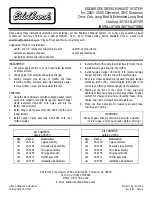
Jump-starting
For the jump-starting procedure, use only the jump-starting connection point, consisting of a
positive terminal and an earth point, in the engine compartment.
G
WARNING
Battery acid is caustic. There is a risk of injury.
Avoid contact with the skin, eyes or clothing. Do not inhale any battery gases. Do not lean over
the battery. Keep children away from batteries. Wash battery acid immediately with water and
seek medical attention.
G
WARNING
During charging and jump-starting, explosive gases can escape from the battery. There is a risk
of an explosion.
Particularly avoid fire, naked flames, creating sparks and smoking. Ensure there is sufficient
ventilation while charging and jump-starting. Do not lean over a battery.
G
WARNING
During the charging process, a battery produces hydrogen gas. If a short circuit occurs or sparks
are created, the hydrogen gas can ignite. There is a risk of an explosion.
R
Make sure that the positive terminal of a connected battery does not come into contact with
vehicle parts.
R
Never place metal objects or tools on a battery.
R
It is important that you observe the described order of the battery terminals when connecting
and disconnecting a battery.
R
When jump-starting, make sure that the battery poles with identical polarity are connected.
R
It is particularly important to observe the described order when connecting and disconnecting
the jump leads.
R
Never connect or disconnect the battery terminals while the engine is running.
G
WARNING
A discharged battery can freeze at temperatures below freezing point. When jump-starting the
vehicle or charging the battery, gases can escape from the battery. There is a risk of an explosion.
Allow the frozen battery to thaw out before charging it or jump-starting.
!
Vehicles with a petrol engine: avoid repeated and lengthy starting attempts. Otherwise,
the non-combusted fuel may damage the catalytic converter.
Do not use a rapid charging device to start the vehicle. If your vehicle's battery is discharged,
the engine can be jump-started from another vehicle or from a second battery using jump
leads. Observe the following points:
R
The battery is not accessible in all vehicles. If the other vehicle's battery is not accessible,
jump-start the vehicle using a second battery or a jump-starting device.
R
Vehicles with a petrol engine: only jump-start the vehicle when the engine and exhaust
system are cold.
R
Do not start the engine if the battery is frozen. Let the battery thaw first.
Jump-starting
363
Breakdown assistance
Z
Summary of Contents for 2013 CLS Coupe
Page 1: ...CLS Coup and Shooting Brake Owner s Manual Nur f r internen Gebrauch For internal use only...
Page 4: ......
Page 30: ...28...
Page 79: ...from the outside Observe the Important safety notes Y page 86 Anti theft systems 77 Safety Z...
Page 80: ...78...
Page 242: ...240...
Page 307: ...Useful information 306 Stowage areas 306 Features 319 305 Stowing and features...
Page 336: ...334...
Page 337: ...Useful information 336 Engine compartment 336 Service 340 Care 341 335 Maintenance and care...
Page 352: ...350...
Page 420: ...418...
Page 421: ...419...
Page 422: ...420...
















































